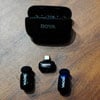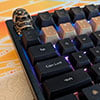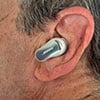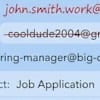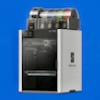We may earn commissions when you buy from links on our site. Why you can trust us.
Reencle Prime Review – Minimal Maintenance, Big Composting Power
Starting last October, New York City (where I live) mandated curbside compost collection. The added benefit for us New Yorkers is less food waste on the streets for rats, gnats, ants, flies, and cockroaches to be attracted by.
For farmers, gardeners, and environmentalists, composting is not exactly news – in most cases, it’s a critical part of their lives. But for most of us, especially city folk like me, the idea of separating out “organics” – food waste and yard trimmings – and creating compost (or “humus”) for either disposal or use as nutrient-rich plant/garden fertilizer is a new aspect of home recycling and environmental awareness.
To comply with the law, my building set up a brown compost bin in the basement for us tenants to dump our compostable food waste into. But this meant keeping smelly food scraps separated out in my apartment until I was ready to take the trek all the way downstairs. Not an ideal scenario, and the reason why many New Yorkers I know simply ignore the requirement.
Coincidentally, Reencle reached out shortly after the law went into affect to see if I’d be interested in testing its latest kitchen composter, the Reencle Prime ($499), one of a growing number of consumer-grade home kitchen composters. Since I was now obligated to designate a separate kitchen container to collect my compostable food waste, I decided to grab the opportunity to try a standalone composter.
I’ve been using the Reencle Prime for around three months and, overall, it made for a welcome assistant for my first foray into the world of composting.
| + Pros | – Cons | ||
|
|
||
|
|||
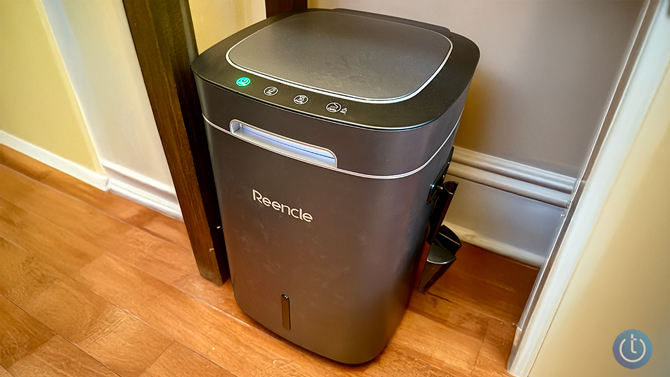
Reencle Prime basics
Reencle makes two home composters, the 3.7-gallon Prime, which I tested, and the 5.8-gallon Gravity. In comparison to the Gravity, the Prime accepts less waste – a maximum 2.2 pounds a day vs. the Gravity’s 3.3 pounds a day, uses slightly more power (1.25 kWh vs 1.128 kWh), and is a bit noisier (29db vs. 24dB). However, for my two-person household, the Prime’s lesser capacity was not an issue, and you’ll only hear it if standing near it in the still quiet of the middle of the night.
Prime measures a slight 18.4 inches high,13 inches wide, and 12 inches deep, and weighs a not exactly light 20.1 pounds. It has a six-foot power cord, so I can store the Prime plugged in under a kitchen utility table and slide it out to my food prep area when I'm cooking or for after-dinner cleanup. Some small wheels would be nice, though, so I wouldn't have to schlep it over.
There are double lids to access the Prime composting chamber. The smaller lid opens automatically with your foot via a sensor at the Prime’s base or via a push-to-open button on top. This smaller lid stays open for six seconds, or you can manually lift the entire hinged top open for as long as necessary to dump larger amounts of waste or to empty once the chamber is full of compost. Unfortunately, when you lift the whole lid, the smaller lid also falls open, risking some food spillage.
On the left inside wall of the chamber is a horizontal white LED that indicates maximum compost capacity; on the inside rear wall is a replaceable and cleanable mesh air filter.
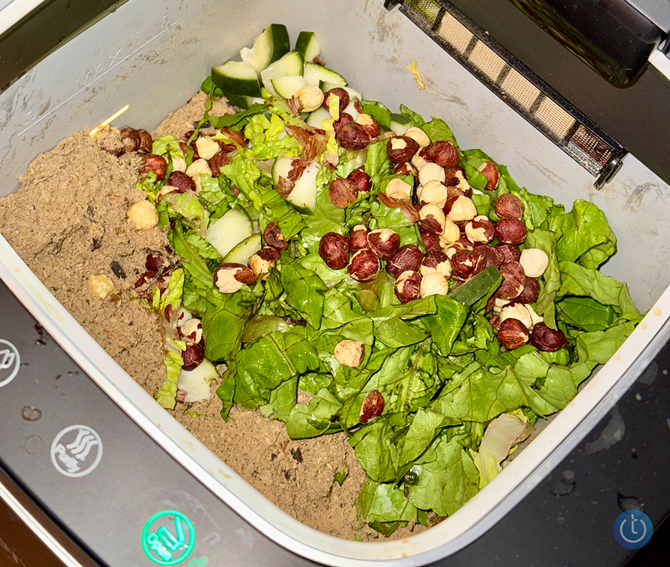
Read more: Typhur Dome 2 Air Fryer Adds Dual Heating for More Even Cooking
How Reencle composters compost
There are many types and methods of composting, some that run on electricity, others that don’t. The most common consumer electrical composters are so-called “drying & grinding” types that dehydrate and pulverize food waste, and slower models that use microbial fermentation.
Reencle’s Prime and Gravity composters are more akin to the latter sort. Using an aerobic bacterial composting system – but not fermentation, which increases interior operational heat by a third compared to dehydrators. To cut the heat of fermentation, the Prime and the Gravity employ a proprietary blend of aerobic bacteria called ReencleMicrobe to decompose organic matter to produce a more natural compost material.
Set-up and operation
Both the Prime and the Gravity come with a Compost Starter bag of small pellets that look like sawdust but actually contain the microorganisms that break down organic waste. You dump all the pellets into the Prime’s chamber, then pour in 50-60 fluid ounces of water – seven cups. Then you close the cover and let the concoction concoct for 18-24 hours, after which you start dumping food scraps into the composter.
What scraps can you dump? The food items you can and can't compost is the one downside of composting – it’s complicated, it’s often dependent on the model, and requires a learning curve.
Some composters, for instance, limit what kinds of waste you can compost, such as raw or cooked meat and fish. Prime and Gravity let you dispose of almost any organic waste, including raw or cooked meat or fish, dairy products, and pasta. No hard organic substances, such as bones, crustacean and other solid shells (crab, lobster, walnut…but eggshells are okay), or large pits (aka avocado and peach). Small soft seeds, such as those from watermelon, citrus fruit, and apple cores, are also okay, but citrus rinds should be chopped up – they contain complex carbon compounds resistant to microbial breakdown.
Anything manufactured, even if biodegradable, such as cigarettes and paper, is a no-no – except for coffee ground-filled coffee filters labeled compostable, and tea bags sans their strings and tags. Also a no-no is heavily salted waste, especially if you plan to use the compost for gardening, since salt-increased soil salinity isn’t healthy for growing things. But Reenacle says dumping soup is okay.
Prime had no problems decomposing relatively large soft waste – whole rotten bananas, whole bread slices, lettuce and cabbage stems, etc. Reencle recommends crumbling up large hard crackers, though, so as not to damage the composter’s stirring rods.
Another Prime and Gravity bonus is not having to wait hours for a composting cycle to complete before you can add more waste. Both models continually compost, so you can toss in waste at any time.
Read more: Why This New Air Purifier Belongs Next to Your Couch, Not Hidden Away
Maintenance
Once the Prime starts composting, you won’t need to order any more starter pellets. As the Gravity churns your waste with the initial set of microbes, the microbes remain as part of your compost and reproduce themselves. This remaining population decomposes new waste and continues the ongoing microbe reproduction and decomposition cycle.
When the Prime’s chamber reaches capacity – mine requires emptying around every three weeks – the position of the stirring rods makes it hard to completely empty the chamber. So, you are helpfully forced to leave an amount of microbe-infested compost in the unit.
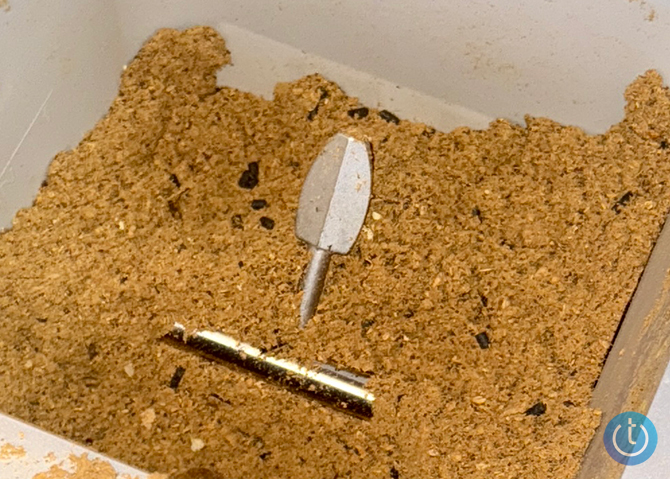
Included with the Prime is a too-small (IMHO) plastic shovel. To empty a filled chamber, you scoop out the compost – which has a musky smell that’s strong, but not unpleasant – into a bag or container. This latter part is where I suffered a composting disconnect.
If you’re disposing of the compost rather than collecting it for gardening, it’s assumed you’ll shovel the compost into a plastic bag. But to me, since plastic bags are not biodegradable, this defeats home composting’s environmental purpose. So, I bought compostable food waste bags. (The Unni compostable bag shown below costs about $0.12 per bag.) And since the shoveling from the Gravity into the bags can get sloppy, I also bought a small, cheap waste basket and used the waste bags as a liner.
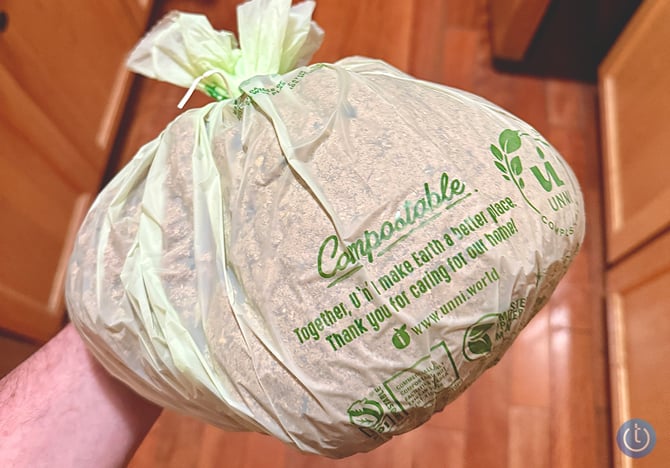
Even then, spillage off the shovel before you get the compost from the chamber into the bag is hard to avoid. You must shovel around the stirring rods, which means you may not be able to get a full scoop. I yearn for a faster, neater, more efficient compost removal solution. But, since I only need to empty the chamber every three weeks or so, this is a minor quibble.
There are two filters you’ll need to keep an eye on. The first is a small rectangular mesh air filter on the rear inside chamber wall. If the filter looks clogged, it can be easily removed, washed, and reinstalled.
The Prime also comes with two charcoal filters – one that attaches to the unit and a replacement that clips onto the back. According to Reencle, if the unit starts to smell, you should replace the first filter, which should last a year or more. Since two filters are included, you’ll be covered for at least two years. Replacement charcoal filters cost just $35, whereas many dehydrator-type composters require filter changes two to three times as often.
Knowing when to empty the chamber, clean the air filter, or replace the charcoal filter is largely up to the user’s judgment. I would have liked some sort of alert light on the unit to at least warn or remind me when to worry about doing any of the three.
The bottom line
Once I grokked what foodstuffs I could dump into the Prime, and once I got into the rhythm of dumping food waste into the Prime instead of the garbage – I’m still developing the put-it-in-the-composter muscle memory – using the Prime made me feel as if I was contributing in my tiny way to the health of the plant.
More practically, my garbage no longer stinks and no longer attracts tiny pests, especially those damn tiny fruit flies that seem to appear out of nowhere and multiply – well, like fruit flies! So, no more noxious Raid pesticide spraying.
As far as the Prime itself is concerned, I wish emptying the chamber were a bit faster and efficient, and that biodegradable food scrap bags for the safe environmental disposing of compost were also included, or at least suggested.
But not being especially limited as to what foodstuffs I can throw in and when, along with the minimal maintenance, makes the Prime a welcome – if moderately expensive – addition to both my kitchen and my conscience.
The Reenacle Prime is priced at $499 and available on Amazon and the Reenacle site. And if you need more capacity, you can step up to the $649 Reenacle Gravity.
[Image credit: Stewart Wolpin/Techlicious]


